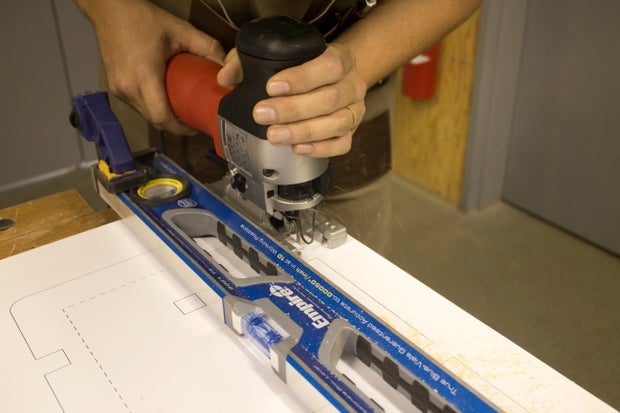Introduction: Sheet Metal Fireplace
This outdoor fireplace is the perfect companion for your patio when there's a chill in the air. It's made of sheet metal and pop rivets, giving it a sleek aesthetic, light weight, and portability. The shape of the chimney also keeps the smoke out of your face!
Step 1: Tools + Materials
At Pier 9, we've got all the awesome tools. I made this project using our CNC water jet and our industrial sheet metal break. But don't worry, you don't need those fancy tools to make this project.
Sheet Metal Brake
Here's a great instructable detailing how you can make your own sheet metal brake with a steel angle, some door hinges, and a piece of lumber: https://www.instructables.com/id/Simple-Sheet-Metal-Brake-No-Welding/

Digital Fabrication by Hand
If you don't have a water jet (come on, get with the program), all you need is a hand drill, a jigsaw with a metal cutting blade, a large format print from a print shop, and some patience. Here's a link to my Digital Fabrication by Hand instructable, showing you how to be your own CNC machine: https://www.instructables.com/id/Digital-Fabrication-By-Hand/

Rivets + Gun
I used this Tekton rivet gun which is $10 on Amazon. I used 1/8" rivets which are plenty strong for this application: http://www.amazon.com/dp/B000NPT74C/?tag=instructabl09-20
Sheet Metal
I used 16 gauge stainless steel for the enclosure, and 8 gauge stainless steel for the platform and feet. Stainless steel is really hard to brake, so I added perforations to make it easier.
I would recommend using light gauge mild steel (16 gauge or less) for the whole project if you don't have access to a manufactured sheet metal brake.
Software
Fusion 360 is free and it's awesome. I use it for everything I design and fabricate.
Student / Educator License (renew free every 3 years)
Hobbyist / Startup (renew free yearly)
Step 2: Design, Model, Layout
The video above details the process of designing the fireplace in Fusion 360. The sheet metal tools are really easy to use, and the automatic unfolding feature made it super easy to make my part layouts.
The .f3d file is the fusion 360 archive- you can upload it to one of your Fusion 360 projects and play around with it as you like. You know what might be cool? Adding some cutout patterns or hole patterns to see the fire through.
The .dxf files are the individual layout parts that you can use if you have some kind of CNC to to the work for you.
The .pdf file is a 48" X 48" sized layout with all the parts on it to scale. To print this out and use it as a template, bring it to a print shop that does large format printing and tell them to print it at full scale / 100% / original size / no scaling on a 48" wide (or larger) roll.
Step 3: Break
With the parts water jet and de-burred, I moved on to the sheet metal brake. The folds all have specific angles they need to be, but since our brake doesn't have an angle gauge, I just eyeballed it. I figured that since the sides were going to be riveted together, I could just use vice grips to take the stress off the rivets and bend them into place by hand.
Step 4: Rivet
To do the riveting, I used vice grips to line up the connected parts. I've never made anything with sheet metal before or used a rivet gun, but I was surprised at how easy it is. You basically just put the rivet in the gun, stick the end of it into the holes to be joined, then squeeze the handles until you hear a pop.
I lined up the holes using 1/8" bolts, then clamped the pieces together with vice grips.
I left one side of the enclosure open, then riveted the platform to the two sides before attaching the front panel. It took a little bending by hand with vice grips holding the parts together. The last thing I added were the feet using the same method with vice grips.
In less than an hour the whole thing was done.
Step 5: Great Success!
This project went really well, all things considered. The holes lined up perfectly, the perforations worked great for making the bending easier, and the metal didn't warp at all when I got the fire going. Since it's stainless steel it'll oxidize a little on the surface (especially the hot spots), but I bet it'll last long enough to be worth the effort.
Comments are welcome, and let me know if you need any advice on the Sheet Metal Workspace in Fusion 360.

















